|
|
Mountain/Rock |
|---|---|
|
|
35.76660°N / 76.18330°E |
|
|
Mountaineering, Big Wall |
|
|
20623 ft / 6286 m |
|
|
Overview
There are some impressive and extremely difficult rock towers around the world, competing in being the hardest to climb. One of the more famous and possibly the group of peaks that would get the most votes for being the toughest is the Trango Tower Peaks. There are two main summits in the central part of the group: Great Trango Tower (6286m) and Nameless Tower (6230m) a.k.a. just Trango Tower.
The group is reasonable easy to access as it is located much closer to civilization than many other popular peaks in Pakistan. You would suspect a peak like Trango Tower is an expensive climb, but it isn’t. Like all other peaks in Pakistan the price tag on the permit is determined by the peak’s elevation and therefore Trango Tower comes at a very affordable price. More about this in the red tape section..
The peaks have some of the highest vertical faces on the planet and were for a long time some of the most coveted mountaineering challenges. It was not until 1975 the area opened for climbing and the race for the hard-to-reach summits began.
Great Trango Tower has three routes straight up the E/NE face and a couple of alpine routes on the NW and W sides of the peak. Nameless Tower has been climbed via many routes, which all are located on its SE and SW faces. It's said the quality of the granite is very good on both the main peaks as well as on the lesser peaks in the area.
Afzal's list of the peaks in the core group.
Trango Group have the following peaks:
1- Kruksum (S)6650-M
2- Kruksum (N)6600-M
3- Trango Ri (II)6515-M
4- Trango Ri (1) 6452-M
5- Kruksum (E) 6300-M
6- Trano Ri (III) 6300-M
7- Trano Ri (IV) 6300-M
8- Great Trango (I) 6286-M
9- Nameless Tower 6239-M
10-Great Trango (II) 6237-M
11-Great Trango (III) 6231-M
12-Munk 6150-M
Temporary Remarks
1). The photo captions are very short, as I'm considering re-scanning all my photos on this page.
2). There are photos on this page showing Uli Biaho, Lak, The Cathedral etc. These peaks are not in the Central Trango Group, but I decided to include them on the page, at least until someone creates another group page or a separate page for any of those peaks.
Climbing History - A Brief
I only list first ascents on new routes plus some other interesting ascents. Please let me know about other climbs you would like to include.
Nameless Tower/Trango Tower
- 1976 British Anthoine, Boysen, Howells and Brown
- 1987 Yugoslav Cankar, Knez and Srot.
- 1987 Swiss-French Piola, Delale, Schaffers and Fouquet (Parapente descent)
- 1988 Swiss-Polish Kurtyka and Loretan.
- 1988 German (et al) Yugoslav route
- 1988 German Gullich, Munchenbach and Albert (Yugoslav route 1st free ascent)
- 1989 Spanish Gallego, Clavel, Rose and Seiguer.
- 1989 German (Gullich, Albert and Stiegler
- 1990 American/French Lowe and Destivelle Yugoslav route (Destivelle first woman)
- 1990 Japanese Minamiura First solo (and new route)
- 1992 Child and Wilford
- 1995 Ogden, Benegas, Starr and Brand
- 1995 Izco, Zabalza and Aquerreta
- 1995 Skinner, Model, Lilygren and Bechtel
- 1997 Hollinger, Barker, Jarrett and Rzeczycki
Great Trango Tower - 1977 Hennek, Rowell, Roskelley, Schmitz and Morrissey
- 1984 Doseth and Daehli (East summit, died on descent)
- 1985 Selters and Woolums
- 1988 Giordani Solo
- 1992 Middendorf and Bongard
Bor adds:
Great Trango Tower 2004:
Great Trango (6287 m): Woolums – Selters 80 st / 50 st, 1200 m
Trango Monk (5850 m): Chota Badla (VII, A2, 70 st, 450 m, first ascend on the summit)
Trango Tower (6251 m): Eternal Flame (VIII-, A2, 1000 m, 1.ascend in alpine style)
These were climbed by Slovenian climbers in year 2004.
Jck adds:
Recently I've read about Pou brothers. Two Basque climbers Iker and Eneko Pou wanted to climb free for the first time the most difficult route on each continent.The started in USA (EL Cap: El nino 8a+/b),then Spain (Narajo: Zunbeltz 8b+),Madagascar (Bravo Les Filles 8b) and Tasamania (Totem Pole: 7b).
In 2005 they made a new variantion of Eternal Flame (first ascent in 1989: Kurt Albert,Wofgang Gullich,Christof Stiegler and Milan Sykora)on Nameless Tower.
In 2003 swiss-spanish team made the route free but without the crux tenth pitch.Unfortunately due to bad weather Pou brothers couldn't climb that pitch free either.So the made a new 50 meters long variantion of that pitch using only few friends.They rated it at 8a. So 10th pitch of Eternal Flame is still waiting for the first free climb. - A link to The Pou borthers site In Spanish.
- More info about this climb.
A collection of links
Todd Skinner – Nameless Tower, 1995. Excellent photos by Bill Hatcher and Bobby Model!
Photo index 1
Photo index 2
National Geographic’s site about Skinner’s Ascent.
Slide show! The photos from National Geographic story - A Norwegian ascent of Trango “Pulpit” (6050m).
Trip report. - A very good trip report by Mark Synott.
Read the story on Mark’s site. - The first ascent of Great Tango Tower’s south-west ridge.
An interesting trip report by Kelly Cordes - Bongard’s story about the 1992 climb.
An interesting trip report - The Grand Voyage.
Middendorf’s extensive climb report. - Middendorf’s account on gear and walk-in.
Information on what you’ll need on an attempt. - Two short articles from the Alpinist.
Great Trango Tower, NW Face
Info by Tomaz Jakofcic - South Africans on Trango.
A climb of Nameless Tower - Risk Online – A Russian mountaineering site.
Topos, a comment by Greg Child, photo galleries etc. - Waldemar Niclevicz - Brazil's finest.
In Portoguese - Interesting about Uli Biaho
Park 5.6 wrote:
Tonight I saw a wonderful slideshow here in Boulder givan by Kelly
Cordes on him and Josh Wharton's ascent of the SW ridge of Great Trango
Tower in the summer of 04. Named the "Azeem Ridge", this route may be the
longest rock climb in the world with over 7,000 feet of pure rock, and was
completed in pure alpine style, even after Cordes dropped half the cams on
pitch 2.
Some info on: Metolius Website.
Trango 2008 - The free Dream Expedition
The Team: Jeremy O'Brien-Gore the expedition leader from UK, Gareth Parry member from UK, Denis Roy member from France, Pierre Muller member from France, David Kaszlikowski member from Poland, Eliza Kubarska member from Poland.
The period: from 27.08.2008 to 26.10.2008
Result: unsuccessful
Local support: Asghar Ali Porik - Jasmine Tours
News reports
If anyone climbs Trango Towers, especially Nameless Tower it make headlines in the climbing news world. - Slovenian Trango Towers debrief: Double success for the Old Men and the Rocking Girls 2006
- Polish teams on Trango 2006
- Slovaks on Uli Biaho 2005
- Pou Brothers variation on ‘almost free’ Eternal Flame> 2005
Commercial Expeditions
There are dozens of companies organizing tours in Pakistan. I choose to list some of those which arrange expeditions specifically to Trango Towers. - Karakurum Treks & Tours Pakistan.
- Monterosa Expeditions Nepal.
- Adventure Consultants New Zealand.
- Adventure Peaks UK.
- Adventures International US.
- Amical Germany. Great Trango Tower.
A useful address:
Alpine Club of Pakistan
Jinnah Stadium,
Pakistan Sports Complex,
Islamabad.PAKISTAN 44000
Tel: 92-51-9208963
http://www.alpineclub.org.pk/
Books & Films
Books
- The Nameless Tower - Jim Curran ISBN 0950627208 Dark Peak Ltd
- Beyond the summit – Todd Skinner ISBN 159184004X Penguin Putnam
- Postcards from the ledge – Greg Child ISBN 0898865840 Mountaineers Books
Films - Great Trango Tower – The Film
- Base Climb Base-jumping from Trango Tower!
- Expeditions - Volume 2: Madagascar - A Woman's First Ascent/Great Trango Tower - A Granite Mile High
Maps
- A clickable map with information about most of the central Karakoram peaks There are also good links to other maps on this page. IN French.
- Interactive map
- A rare Italian map of the area
Getting There
Trango Towers is a long way from any arrival point in Pakistan. Sooner or later you have to pass Islamabad as this is the town where you get the permits for the peak. If an organizer have taken care of the arrangements for you, you can just relax and follow your guide through the country. If you want to arrange everything yourself, the following may be of help.
From Islamabad to The Northern Areas.
Local buses serve Islamabad with Skardu (the normal starting point for the trekking) well. Catch a bus from NATCO or Masherbrum Tours from Pirwadai in Rawalpindi (twin city of Islamabad, 15 km away). The cost for the 22-30h journey is about 12 US$. A taxi from central Islamabad will cost you 200-300 Rps. Some buses stop overnight in Besham, some go straight through to Skardu. If you have booked a ticket on a direct bus, don't be surprised if you have to wait in Besham for some time. Usually this wait is for other buses to gather and also for the police/military to ready a convoy. There are almost always some minor unrest in Indus Kohistan and to play it safe, the authorities arrange a convoy for the night traffic. It's nothing to worry about, it's standard procedure in this area.
From Skardu to Trango Towers
There are two routes to the peak from Skardu - via Askole or via Gondogoro Pass. The former is to recommend if you're not acclimatized. Gondogoro Pass is a mighty 5600m, so most trekkers use this route for the way back. It’s also a very long detour and can be seen as an interesting alternative walk out route.
To Askole
A jeep ride takes 6-8h on partly miserable roads and the going price in the summer of 2005 was 3500-4000 Rps.
In Askole you can either camp out in the wild or use the one of the camping places, which will cost you 100 Rps. Facilities includes toilets, running water and a grassy, walled camping area.
The first camp site along the route is Jhula. It takes anywhere between 4 and 8 hours to reach Jhula from Askole and the trek is very straight forward. Most of the time you walk on good paths along a river. An early start is recommended as it gets very hot in this area. Two bridges where you have to pay a small fee have to be crossed. Jhula has shower cabins, running water, toilets and camp platforms. 100 Rps./night.
Normally, there is not a problem to reach Paiju the second day. The trek is harder as you sometimes walk in sand along the rivers and there are some ups and downs en route. Paiju has the same facilities as Jhula and the cost to camp there is also 100 Rps./night. The place can be very crowded in the high season and if you don't like that, just continue for another 20 minutes to the first stream or to where the glacier start, where a very good place to camp is situated. Fresh water available here.
The next camping place is Urdukas, which has very good views of Trango Towers. The Urdukas camp site is situated on a hillside with good camp spots. Facilities and price is the same as Jhula and Paiju. If you want to go further or a part of the way to Urdukas, remember you'll be camping on the actual glacier. Campspots can easily be found there as well, but in some parts there are half an hour in between good or/and safe ones.
You don’t have to go all the way to Urdukas camp, as you can cross the glacier and head straight for the peaks. It’s the last “real” campsite and from now on it’s only primitive camps in the wild.
The last day to the foot of Trango Towers is on rough tracks and not at all like the well-travelled paths leading to the Baltoro mountains (K2, the Gasherbrums, Broad Peak etc.). There are crevasses along the way and rock falls from the steep high faces is a concern. To acess Nameless Tower, you either walk up the Trango or Dungee glacier. Great Trango tower is reached via Dungee glacier and is supposed to be a dangerous approach as it includes objective dangers and rough terrain.Paiyu Peak
The mountain is Paiyu (meaning salt in local Balti language)which is situated short of snouts of Baltoro glacier. It is not part of Trango Towers as indicated in the report. It was first attempted in 1974 by an American Pak Expedition led by Mr Nicholas B Clinch of American Alpine Club and included Tom Hornbien (Everest summiteer) besides Dick Emerson and others. Alpine Club of Pakistan members included Saeed, Jawaid and Momin. During a descent from Camp II, Momin slipped and rolled down over 1200 ft and was killed which forced the Expedition to abandon.
In 1975 a French team was forced to abandon climb due to another accident.
In 1976 Alpine Club of Pakistan with the support of American Alpine Club launched an all out Pakistani expedition to the mountain under my leadership which was able to reach its summit after two days hard climb from last camp on 21 July 1976. Summiteers included Nazir Sabir, Bashir and myself. Mr Allen Steck from AAC, our coach opted not to go to the summit. Other members of the expedition were Jawaid, Saeed, Ayaz, Yousufzai, Amjad and our coach Allen Steck from AAC.
This year we celebrate 30 years of its first ascent. The climbing report appeared in American Alpine Journal of 1976.
The climb was made along the left skyline of the mountain. We establsihed four camps on the mountain. Our Camp II (18,000 ft) was on the left edge on top of the second ice ledge (from left) and our route followed along the couloir above this ice ledge. Our camp IV (20,500 ft) was behind the rock pinnacle below the summit pillars on the left.
For the summit attempt we left our last camp at about 0030 AM on 20 July with the hope to reach the summit and return back same evening. We had to cross wide bergshrund and made over 20 pitches (both vertical and lateral) on very hard ice and rocky patches (in between) before reaching below the snow field which joins the lower peak (visible as the main peak in the photo) and the main icy peak (shrouded by the visible peak) late after sunset on 20 July. As we had expected to return back same day we had not carried sleeping bags, tents and much of food. We had to dig snow cave at this location to spend the night. Next morning it took the tired exhausted Nazir Sabir and myself many hours to do the last climb to the main icy summit, rising about 300 ft above the snow field. At last we reached the summit at 2 PM on 21 July. Bashir joined us later. We returned back to Camp IV after very difficut and torture some rapelling at about 1030 PM on 21 July.
Info by: Manzoor Hussain
Alpine Club of PakistanWalking out via Gondogoro Pass
Trango Towers are far away from Gondogoro Pass, but if you have the time and the energy and want to walk another way out, this is a beautiful alternative to walking back via Askole.
Gondogoro Pass (or La as it is in the local language) is sometimes stated to be the highest pass in the world and the altitude given on many maps are over 5900m. It's not that high, but at 5600m it's still a very impressive pass. Many teams choose to walk out this way because of the outstanding views from the pass summit. Masherbrum (7821m) is very close and to your NW you see the whole Gasherbrum group, Chogolisa (7665m), Baltoro Kangri (7800m) and a lot of other high beautiful peaks. To the north K2 and Broad Peak are visible. In the south the extraordinary Laila Peak can be seen.
From urdukas it’s one long day to Concordia. There are some camps along the way, but they are all very basic, consisting of shelters built of rocks. Some groups stop at Goro II, some stop an hour before this camp, Goro I and some go all the way to Concordia.
Concordia, which could be one of the most beautiful places on earth is sadly full of garbage and human waste. To the left you can see Broad Peak and K2. Ahead you Gasherbrum IV is looming and to your right is the impressive Mitre. No fees and no facilities in Concordia.
From Concordia it's a long day's walk to Ali Camp. First you walk past Mitre Peak and head up the next valley/glacier on your right hand side. Watch out for rock falls when entering the valley and try to gain access to the icy part of the glacier as soon as possible. Better to walk up there then down in the scree. When approaching Ali Camp, watch out for crevasses. The "security team" of Ali Camp will scream at you, where and where not to walk.
Ali Camp has a 100 Rps./night fee. Ridiculous prices for "nature preservation" (there's loads of garbage all oer the place), "guiding services" (I never saw any guides when I walked over the pass) and "security" (some bad plastic ropes, attached in extremely bad way is to be seen close to the summit of Gondogoroa Pass) has to be paid. For 1-3 persons it's 2500 Rps. For 4-8 persons it's 4500 Rps. The pass is privately owned. That is probably why this scam can go on as it does. My advice is to bugger the "guides" staying in Ali Camp about the garbage and not trusting the ropes at all.
I was told the it would take 5-7 hours to reach the pass from Ali Camp. It took me 2.45. For an acclimatized mountaineer, this is probably normal. It can be very windy on top of the pass, as it is a lot of elevation drop on the SW side. Don't trust the ropes on this side either. It's quite steep on this side (40-45 degrees). Stay up high on the right hand side if no tracks. There are glaciers in the middle of the glacier further down. The path gets really good before the little camp site of Xhuspang/Shispang, where you also can get very basic meals.
The glacier gets more difficult to travel after the camp and when you have passed the first rocky part and entered the main valley, stay to the left all the time. Doing so makes you avoid all the large crevasses and the left hand side is also the side you leave the valley on. When at the bottom of the first valley, take a left and enter some very nice meadows with yaks. Excellent views of sharp peaks. Some tricky, slide sections have to be passed. The walk gets easier again when heading down the lower part of the Gondogoro glacier towards Shaishcho. In this little settlement you can eat and pitch your tent under nice-smelling wild roses. 100 Rps./night per tent.
From here it's a very easy 3 hour walk to Hushe.
The Hushe - Skardu road is of awful condition for the first couple of hours. In the summer of 2005 the road had been badly cut away by a big river and all travellers had to walk over a wild river on small logs. Other jeeps were waiting on the other side. Lots of apricot orchards followed. From close to Khaplu the road is asphalt all the way into Askole. Count on 5-8 hours from Hushe to Askole.
Red Tape
Visas:
Visas are required by nationals from most European and English-speaking countries. Validity period and cost varies a lot depending on which passport you carry.
Some Pakistani Embassies around the world
Visa extensions are available in most major cities in Pakistan, but should be avoided in the really large cities as it can be a long and nerve-wrecking experience. For Trango Towers climbers, Skardu is a recommended place for extensions. See also the Skardu section
Permits for Trango Towers
In Pakistan you need a permit to climb any peak over 6500m, which can be obtained either via the Ministry of Tourism or via an expedition agent. As all the peaks in the Trango Towers group are lower than 6500 meters they can be climbed for free! You don't even need a liaison officer (LO). You do have to travel with a group which has a LO when passing the military checkpoint some hours out of Skardu. If going in via Gondogoro Pass/Hushe, theoretically you don't need one at all, but you better ask about this.
Instead of a LO, you need to do the walk-in with a Ministry of Tourism approved guide. It's is much cheaper and straigh forward than dealing with a LO.
A trekking fee is also appliciable in the Trango Tower area. It's US$50/person.
An environmental fee of $200 also have to be taken into account.
There's a refundable bond for emergency rescue (helicopter) of $6000 which most expeditions have to pay. Trango Towers is located in an area where the authorities usually don't ask you to put down this bond, but I've heard the severity of the climb makes the officialdom asking for it anyway.
Additional info about permits (not applicable if you only aim for Tango Towers).
If going independently, you're supposed to pay the salary for the LO. Here's the full story, which also give you info about the obligatory briefing and de-briefing. - K2's royalty fees: 6000 USD for a team of seven, 1000 USD each additional climber.
- All other 8000ers, Gasherbrum I and II, Nanga Parbat, and Broad Peak: 4500 USD for a team of seven, 750 USD each additional climber.
- 7500 to 8000 meters: 2000 USD for a team of seven, 250 USD each additional climber.
- 7000 to 7500 meters: 1250 USD for a team of seven, 200 USD each additional climber.
- 6500 to 7000 meters: 700 USD for a team of seven, 100 USD for each additional climber.
2010
Karrar Haidri, representing the the Executive Council Alpine Club of Pakistan forwarded me the following information.
Government of Pakistan vide Notification. 1(1)/2002-OP, dated 15th October 2008. In suppression of all previous notifications regarding announcement of concessions for Mountaineering, Ministry of Tourism, Government of Pakistan has decided to continue reduction in royalty fee during the calendar Year 2010 as per details given below:
1. Zero royalty fee for peaks up to 6500-M.
2. 10% royalty fee on mountains situated in Chitral, Gilgit and Ghizer except on Spantik/Golden Peak.
3. 05% royalty fee on all peaks during winter season (December- February).
4. 50% discount on royalty fee on all peaks except as mentioned in (1) and (2) above as per following break-up:
The prices after reduction:
K-2 8611m $6000 for 7 member for additional member $1000
8001-8500m $4500 for additional member $750
7501-8000m $2000 for additional member $250
7001-7500m $1250 for additional member $200
6501-7000m $750 for additional member $150When To Climb
The normal climbing season for the mountains in this area of Pakistan is from June to september. Many other peaks are attempted in other times of the year, even in winter, but as the Trango peaks are pure rock climbing it's out of the question to go there in the off season. The exception is Great Trango Tower, which has some easier routes off the main rock pillar which can be attempted any time.Camping
It's allowed to camp anywhere along the route to Trango Towers. Most climbers who go to the area have bought a package deal from an organizer and therefore a high majority of campers stay in the official campsites along the way. The ones en route to Trango Towers are clean and well-equipped places, but if you choose to walk out via Gondogoro Pass, some looks more like garbage dumps (Ali Camp and Concordia). Some are only detectable by some spartan wind shelters built with piled up rocks.
Apart from the camps at Paiju, Jhula and Urdukas there is no reason to stay at the official places as they often are crowded and noisy places.
Pitch your tent anywhere, but be careful with the water conditions close to places where many people camp or have camped.
Mountain Conditions
There are few mountains in the world for where the weather reports are more important. On most other peaks you can always find some sort of a shelter or dig an ice cave. If a storm or a blizzard hits Trango Towers while you’re on the face, you’re instantly in serious survival conditions. Anyone even thinking about an attempt should bring top-notch communication systems.
A good weather forecast site:
The K2 weather report also apply for Trango Towers
Main site of Adventure Weather.com
aaporik recommends weather forecasts from Pakistan Weather Department
The caretakers of the Urdukas Camp seems to get forecasts and there are always lots of international mountaineering expeditions there. If you for some reason lost your own gear, this is a last resort for weather forecasts.
Porters
Contrary to what some organizers are telling you, you can arrange the trek all by yourself.
The porter salary system was strict and worked fine until 2004, when massive amounts of climbers arrived for the K2 anniversary. A shortage of porters made some organizers desperate and they had to bid over the governmentally fixed prices. This created havoc and the whole porter salary system collapsed.
The cost for a porter is now down to your bargaining skills. Officially it should be roughly 1600Rps. to Trango Towers BC, but count on paying as much as 3000Rps.
Porters can be found in Askole, but if there are a lot of expeditions leaving when you get there, there's a high risk there is none available. Better book beforehand. The organizers are not very happy to help you out with this, as they want to include you in a group, but the small hotels in Skardu can usually help you. The price mentioned above is the full price, which include sunglasses, gloves etc. for the porter.
What is not included in the price are the below items and you have to supply the group of porters with the following: - A kerosene stove
- Kerosene
- A tarp or a sheet of thick plastic which serves as a tent/shelter.
- Food
All the above is best bought in Skardu.
Food/porter 600-800Rps.
The rest on the list 600Rps. (10 litres of kerosine).
You can choose to pay the food money directly to the porters, or you can walk around with them and buy the food. Discuss it with the porters and come to an agreement.
If you walk out via Gondogoro La/Pass try to find porters living in Hushe. The porters coming from the lower parts of the Baltoro glacier are much more prone to strike or turn around then the Hushe porters. The latter just want to have the job done/going home and are very seldom creating any trouble.Skardu
Skardu is a little town where you'll spend a day or two and is the last outpost of "real civilisation". Some info that may be useful. - You can extend your visa here, regardless of what some organizers tells you. Go to the DP (Deputy Comissioner) Office. It takes an hour or two to get the one month extension. Prices depends on your nationality. The DP Office is to be found in the nothern end of town, close to the K2 Guest House.
- There are plenty of hotels in Skardu. The top end places are K2 Guest House and Masherbrum Hotel. The former is known for it's cozy garden and the latter for over-priced food. Prices ranges in between 1500-2000 Rps./night. Cheaper alternatives are to be found along the main street. A good value hotel is Gasherbrum Hotel on the main street. 300 Rps./night for a large double is a good deal and the food in the hotel's restaurant is excellent and the portions are monstrous of size.
- Camping and mountaineering shops sells everything you can find in their equivalents in the west. Prices varies. Gas canisters for example, are expensive, but down-suits can be bought for 200US$! Almost everything here is second hand.
- Food shops. There are plenty of them along the main street. Don't expect to find much more than the staples. You can find all the necessary food here if you're not picky and can put up with pasta, soups, porridge etc. for the weeks at Trango Towers.
- If you hire your own porters, you better buy the stuff they need in Skardu. Further up the valleys it'll be way more costly and it's not 100% you'll find what you look for. See the porter section for more details about this.
Basic information about Pakistan
Money & Costs
Currency:
Pakistani Rupee.
141.60 Rps = 1 US$ in April 2019.
Relative costs:
Road side restaurants: US$ 0,5-1,5
Budget meal: US$2-3
Moderate restaurant meal: US$3-8
Top-end restaurant meal: US$5-10
Budget room: US$1,5-5
Moderate hotel: US$10-15
Top-end hotel: US$22 and up
By staying in hostels or dorms and eating like a local you can get by on as little as US$3-10 a day. If, however, you were looking for a moderate touch of luxury you could spend as much as $30-40 a day which could get you accommodation that included a satellite T.V., a desk, a balcony, and a spotlessly clean bathroom. As in any place you can spend as much as you like to live in the lap of luxury and stay in swanky hotels. It's worth noting that rooms and food are cheaper in the north than in the south.
Both travellers cheques and cash are easy to change throughout the country, but commissions on cheques can be high. Apart from top-end hotels most places won't accept credit cards as payment although you can often use them for cash advances at western banks. Facilities for validation seem better for Visa then Mastercard. Occasionally a tattered note will be firmly refused as legal tender, and often in the smaller towns the appearance of a 1000 or 500 rupee note will cause consternation and an inability to provide change so make sure you get some smaller notes when buying your rupees.
A reliable place for using Visa/Mastercards (ATM and cash withdrawals) is the Citibank in the Blue Area in central Islamabad.
Tipping
Baksheesh isn't so much a bribe as a way of life in Pakistan. It can apply to any situation and is capable of opening all sorts of doors, both literal and metaphorical. Anything from a signature on a document to fixing a leaking tap can be acquired through the magic of baksheesh. Most top-end hotels will automatically add a 5-10% service charge to your bill so any extra tipping is entirely up to you. Taxi drivers routinely expect 10% of the fare, and railway porters charge an officially-set Rs 7. The only time that a gratuity might not be welcome is in the rural areas where it runs counter to Islamic obligation to be hospitable.
As everywhere else, make sure the tip is not over the top. It only makes it hard for both future travellers and the locals.
Be sure to read the situation right before using the baksheesh way. Some officials and army personal can be very touchy and it can really backfire offering the wrong person a baksheesh.
Bargaining
If baksheesh is a way of life, bargaining is a matter of style, particularly in the many Pakistani bazaars. Unlike the western hesitancy for bargaining, shopkeepers in Pakistani love to bargain as long as it's done with style and panache. Bargaining usually begins with an invitation to step inside for a cup of tea followed by a little bit of small talk, a casually expressed interest by yourself in a particular item, a way-too-high price mentioned by the seller, a way-too-low counter offer by yourself and eventually, after much comic rolling of eyes, a handshake and mutual satisfaction for both parties. Bargaining should always be accompanied by smiles, good humour and an ability not to get fixated on driving the price into the ground.
Climate in the different provinces
The best time for travelling to Pakistan depends on which part of the country you intend to visit. Generally speaking the southern parts of Pakistan including Sind, Baluchistan, Punjab and southern NWFP are best visited in the cooler months between November and April. After that it gets uncomfortably hot. The northern areas like Azad Jammu Kashmir, and northern NWFP are best seen during May to October before the area becomes snowbound. The weather may be a little stormy during this time but the mountain districts are usually still accessible.
Ramadan
Try and avoid Pakistan during Ramadan, the Muslim month of fasting which, usually occurs sometime during the months of December to early January. This is because a fasting Muslim is an understandably cranky Muslim, and you may find yourself involuntary joining in the fast because activity is kept to a minimum and food is hard to find during daylight hours. Pakistanis are usually very understanding when it comes to westerners who aren't muslims. Even if there are no tea or food served to muslims, these items are most of the time readily available for believers in other faiths.
Security
The security situation in Pakistan deteriorated through 1997, with areas previously considered safe experiencing the same sort of violence and crime as in the long-troubled Sind region. As well as the danger of being caught up in sectarian skirmishes, travellers have been the specific target of violence in Karachi and Lahore.
Sind, the region in the south of Pakistan which includes Karachi, was known as the `Unhappy Valley' or the `Land of Uncertainties' by ancient travellers. Switch to the present day and news of curfews, foreign kidnappings and atrocities between the two main ethnic groups - Sindhis, the province's indigenous inhabitants, and the Mohajir, Muslim refugees from India - suggests its former name is still not out of place. With robbery, smuggling and gun-running amongst Sind's biggest
industries, the province remains a highly dangerous place to visit.
Travel to Sind as well as to the North-West Frontier Province, Punjab and Baluchistan should be undertaken with caution and only after consulting a national foreign affairs department prior to departure or a consulate in Karachi for current information.
Many low end hotels are infamous for theft from the rooms.
The Northern Areas are usually very safe and out of a climbers point of view this is the most important issue. The worst you probably encounter is snotty kids throwing a rock or two and a really annoying feature is the "one-pen-kids". Please do not encourage this behaviour by handing out gifts willy nilly. It only creates greed, beggary and a hell time for forthcoming travellers. If you want to give pens, hand it over to the local teacher/local.
Health
Shots against dengue fever, hepatitis A, malaria and, in rural areas, Japanese encephalitis are recommended.
The tap water should be avoided all over Pakistan.
Giardia and amoebic dysentery is endemic all over the country and Flagyl (metronidazole) is one of the more essential drugs to bring.
Miscellaneous
Time: GMT/UTC plus five hours
Electricity: 220V, 50 Hz
Weights & measures: metric
Tourism: 424,000 visitors - For more information about Pakistan
- One of Pakistan's biggest newspapers online
- Pakistan's official site for tourism
External Links
- A very interesting trip report by Mark Synott
- Kelly Cordes climbing Trango
- Bongard's climb of Great Trango Tower
- Middendorf's climb
- Jasmine Tours - Pakistan
Local Expedition organizer for all peak in Trango area (Trango Tower, Great Trango, Nameless Tower, Hina Brakk, Shipton Spire) - The Pou brothers makes and "almost free ascent" of Nameless Tower.
An interesting story about a variation on Eternal Flame.


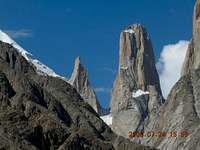
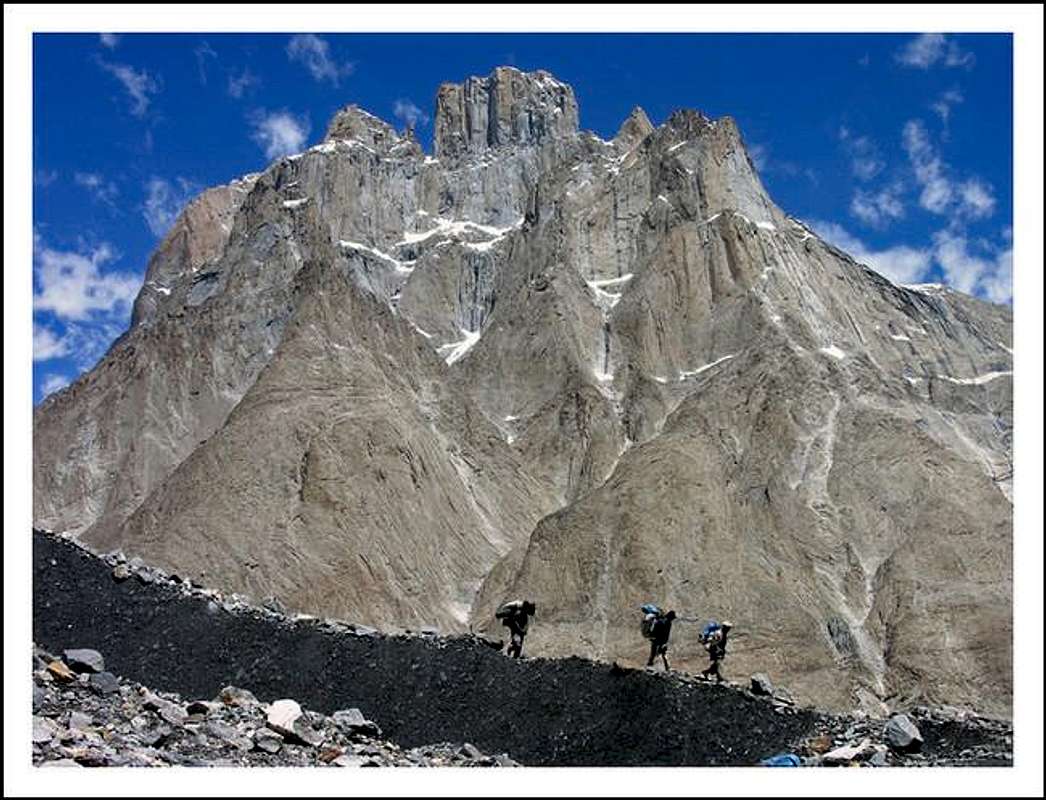

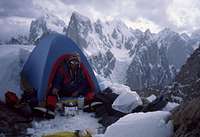
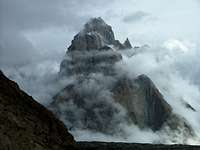
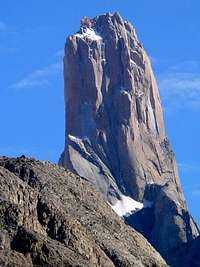

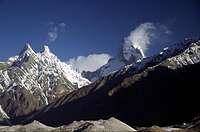








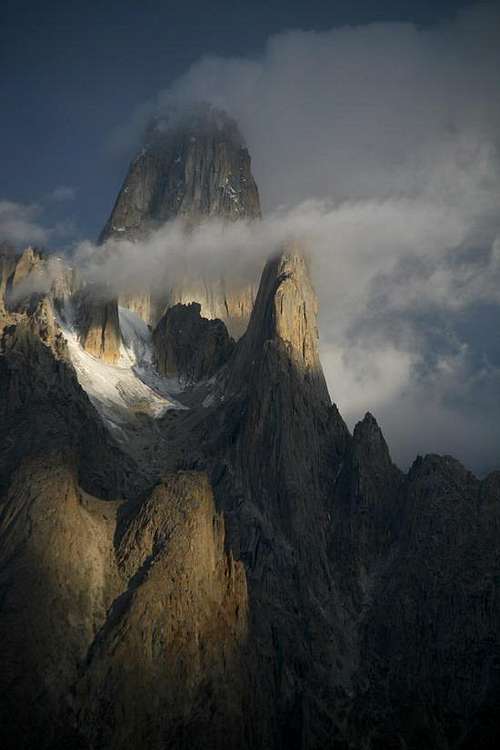
manub - Oct 21, 2006 10:30 am - Voted 10/10
DestivElleHello! Correct name of the first woman climber is Catherine Destivelle (and not "Destiville"). Congratulations for this very comprehensive page. e
Corax - Oct 21, 2006 10:45 am - Hasn't voted
Trango Towers - Catherine DestivelleThanks for the remark. I have changed the spelling and linked her name to her personal web site. Cheers, Janne.
aaporik - Oct 6, 2009 3:03 am - Voted 9/10
Trango 2008 - The free Dream ExpeditionThe Team: Jeremy O'Brien-Gore the expedition leader from UK, Gareth Parry member from UK, Denis Roy member from France, Pierre Muller member from France, David Kaszlikowski member from Poland, Eliza Kubarska member from Poland. The period: from 27.08.2008 to 26.10.2008 Result: unsuccessful Local support: Asghar Ali Porik - Jasmine Tours
Shahid Hussain - Apr 20, 2019 4:29 am - Hasn't voted
updated informationThank you Corax for the great information about Trango Towers. Money & Costs Currency: Pakistani Rupee. 141.60 Rps = 1 US$ in April 2019. Flight from Islamabad To Skardu is very frequent. Pakistan International Airline is operating an Airbus PK451on daily basis. From Islamabad To Skardu is now only 20-22 Hours drive via Babusar Pass or via Karakoram Highway. It would be wise to contact a local Tour Operator to organise the trip, Documentations and get up to date information. One of the oldest and Government licence Tour Operator from Skardu is Trango Adventure. they will be happy to provide the Latest and up to date informations. info@trangoadventure.com https://www.trangoadventure.com
aaporik - Nov 7, 2023 9:08 pm - Voted 9/10
Mountains below 6500 metersAll mountains below 6500 meters are free to climb without any royalty fee, however if the mountain is located in restricted zone such as Baltoro glacier, Hushe Valley, Panma area, you need trekking category visa, trekking permit 50 dollars per person adventure fee and cknp fee 150 dollars per person and the tour operators' package which you might need to buy and includes this in the package. All mountains below 6500 meters in open zone such as Shimshal, Hunza, Nanga Parbat, Biafo glacier, Spantik area are free to climb with and without tour operator's package and with tourist category visa.